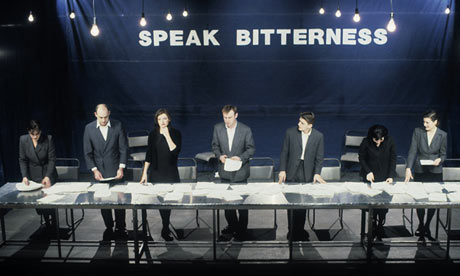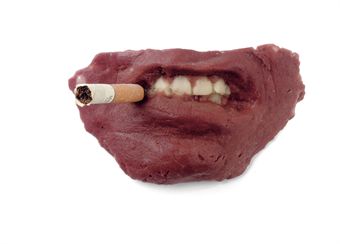'Listen to
"The music of
'Listen to Britain' was made in 1942, directed and edited by Humphrey Jennings and Stewart McAllister. It is a documentary which captures the character of a nation at war, a nation whose identity was perceived to be under threat. The film combines the landscape of
The use of music is prominent in both films as a structuring device, however there are clear differences in terms of the creation of mood and pace. In 'Listen to Britain', music is used as an anchoring device, rooting a sense of national pride and identity, which it does in a straightforward manner; e.g., the use of the piece 'Rule Britannia' is played over a juxtaposition of four shots, in order; industrial chimneys, the stalks of corn, different chimneys and a panoramic shot of the countryside. By a synthesis of these filmic elements, there is a creation of currency between them. The landscape, agriculture and industry are seen as intrinsically British, consequently the physical manifestation of these concepts can be seen to represent an aspect of Britishness. So the music is the structuring device both in terms of montage and creation of meaning.
There is also a reliance on live music as a structuring device in 'Listen to Britain'. This seems to root sequences to a particular place, evoking a certain atmosphere; the dance hall, the pub, the concert hall. The first of these sections, the dance hall features a combination of short, intimate shots of individual people, many of whom are soldiers, with wider shots encompassing the entire hall with a wave of dancers undulating in time with the song 'Roll Out The Barrel'. This sequence juxtaposed at either end with medium shots of two soldiers who appear to be keeping watch over the sea. The presence of these two shots implies that the soldiers, representatives of H.M. Armed Forces, are protecting ordinary citizens whilst they enjoy themselves. This filmic movement can be seen to be employing a rhythmic mode of editing, whereby cuts occur in time with the rhythm of the song. There is a congruence of rhythm in the individual shots also, but it is not established visually that the music and the dancers were filmed in the same location.
The third example of 'live' music in 'Listen to Britain', but the second cited, is a performance by pianist Myra Hess. This movement has much in common with our piece 'Kids' in terms of its musical structure and the manner in which it moves to a sense of climax. As the pace and intensity of the performed music increases, so the intensity of the individual shots and the pace of the cuts increases. Thematically, the change in intensity allows for a juxtaposition between the concert goers, one of whom is the (then) Queen of England and workers in a machine shop, which are tonally much darker and rhythmically more hectic. The presence of the Queen juxtaposed with other members of the audience, relates her to those people, creating a sense that she is 'one of us', another important aspect in terms of the structure of 'Listen to Britain' as a whole, that of creating a sense of coherent national identity.
The use of children in 'Listen to Britain' not so much as a structuring device but in terms of intellectual montage and their subsequent contribution to the theme of the piece was interesting in comparison to 'Kids'. The most notable difference was the creation of a sense of childhood innocence, firstly by the long shots of the children dancing in the school playground, the act of dance being ritualised and devoid of any sense of childish play, the sequence of long to medium shots drawing the spectator into the playground. Secondly, the juxtaposition of these shots of children playing with the shots of the woman looking out of the window, the picture of a soldier and the tank rumbling through the street. This juxtaposition does two things; it creates a connection between the woman at the window and the man in the photograph, he becomes her husband and the spectator is invited to speculate on whether she is an anxious wife or a widow. The juxtaposition also ironicises the shots of the children, they become symbols of defiance (as well as the future), as depicted in the single lingering close-up shot of a girl smiling, featured between shots of a tank moving through what appears to be a small town street.
Music is the dominant structuring device throughout 'Kids'. Although sharing this approach to rhythmic and metric montage with 'Listen to Britain', it is in tone and theme that the two differ most. 'Kids' attempts to play on the use of 'O Fortuna' in the 1976 film The Omen, in this context creating a sense of humour from the juxtaposition of the music, already imbued with a sinister, satanic meaning, and the rhythmically and tonally matched visuals, which thematically are comparatively mundane. 'Listen to Britain', on the other hand, uses music with established associations in order to re-assert these meanings, so whilst the means is ultimately the same, the effect is the opposite.
The use of the first two pieces from Carl Orff's 'Carmina Burana' in reverse order was a trade between the narrative structure of the original arrangement, and the rhythmic and tonal structure of the new arrangement. In terms of the raw footage, as with the music, it was decided to move away from a narrative approach to structuring in favour of creating a sense of general 'childishness' and secondary to this, a sense of individual character. The opening sequence of shots, which features the diegetic soundtrack of one child singing 'Twinkle Twinkle Little Star', intercut with abstract shots of children's feet walking, attempts to draw the spectator into the experience of the children and also to serve as a build up of expectation. So whilst there are narrativistic structuring devices within the first movement, the second and third attempt, through a more rhythmic and tonal approach to montage, attempt to convey a sense of place, time and character. The sense of frustration from a lack of narrative structure, despite the presence of characters, can be summed up in the final shot of the small boy running towards the lake. The length of this shot differs greatly from the sequence that it follows, resulting in a physical reaction; a sense of uneasy relief followed by the frustration due to lack of closure in terms of theme.
Bibliography
Corner, John (1996) The Art Of Record.
Sonnenschein, David (2001) Sound Design. Michael Wiese Productions, Not given
Listen To
Kids (2003) Doig, Steph; Hughes, Laura and Turrell, Brian
www.imdb.com



